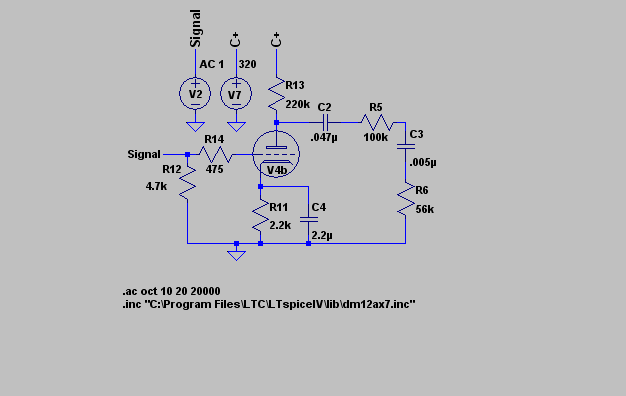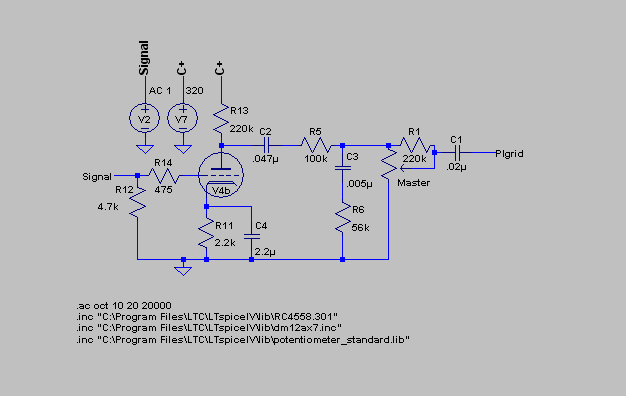Okay, so my understanding that the purpose of an FX loop is to offer you an insert point between the preamp and power amp, so that any effects that sound best post distortion can be run after the preamp adds the dirt, instead of getting dirtied up themselves by running them in front of the amp. If that's the case, would you want any tonal shaping in the FX loop itself (rolling off or boosting highs, lows or mids) or would you want the frequency response through the FX recovery and drive stages to be as flat as you can reasonably get it?
I ask this because of the FX loop setup in my Mesa Nomad. While I'm generally happy with the tones I'm getting out of it, a muddy sound is a common complaint with the Nomad, and nerd that I am, I had to ask why. So I grabbed the schematic off the Internets and played with LTSpice for a bit. The proposed fix for the muddy sound is to cut the 120pF caps out of the phase inverter, but SPICE says the only difference that makes is the highs being down -.1dB at 10kHz, instead of -.9dB. Frequency response is flat from lows to mids to highs regardless of the plate bypass capacitors. So unless I'm doing something very wrong here, I don't think the mud is coming from them.
going back one stage in the schematic revealed that the FX loop is always on, whether or not it is in use. All the signal from the preamp goes through the FX driver/buffer stage, and the recovery stage before it hits the phase inverter and power tubes.
Here's the schematic that I put into SPICE and the frequency response graph it returned.


The Green line is the frequency response as it comes off the plate, the blue line is from the junction of R5 and C3, from which it goes to the phase inverter. It seems to me that the lowpass filter formed by C3 and R5 is sucking all frequencies higher than the low mids. That would be a good way to make a muddy sound, yes?
What I'm trying to figure out is why Mesa designed it like that, and what to do about it. I can imagine maybe the preamp is voiced to bright and fizzy and and the FX loop was configured like this to balance it out. Seems like a weird place to do it, wouldn't the preamp or tonestack be a better place to do it? Maybe the amp has too much gain and it's necessary to roll off as much highs to keep the amp stable? But if that were the case, is rolling off everything past 100hz Necessary? Couldn't frequency response be kept flat until 3kHz, 5khz or even 10kHz?
I ask this because of the FX loop setup in my Mesa Nomad. While I'm generally happy with the tones I'm getting out of it, a muddy sound is a common complaint with the Nomad, and nerd that I am, I had to ask why. So I grabbed the schematic off the Internets and played with LTSpice for a bit. The proposed fix for the muddy sound is to cut the 120pF caps out of the phase inverter, but SPICE says the only difference that makes is the highs being down -.1dB at 10kHz, instead of -.9dB. Frequency response is flat from lows to mids to highs regardless of the plate bypass capacitors. So unless I'm doing something very wrong here, I don't think the mud is coming from them.
going back one stage in the schematic revealed that the FX loop is always on, whether or not it is in use. All the signal from the preamp goes through the FX driver/buffer stage, and the recovery stage before it hits the phase inverter and power tubes.
Here's the schematic that I put into SPICE and the frequency response graph it returned.


The Green line is the frequency response as it comes off the plate, the blue line is from the junction of R5 and C3, from which it goes to the phase inverter. It seems to me that the lowpass filter formed by C3 and R5 is sucking all frequencies higher than the low mids. That would be a good way to make a muddy sound, yes?
What I'm trying to figure out is why Mesa designed it like that, and what to do about it. I can imagine maybe the preamp is voiced to bright and fizzy and and the FX loop was configured like this to balance it out. Seems like a weird place to do it, wouldn't the preamp or tonestack be a better place to do it? Maybe the amp has too much gain and it's necessary to roll off as much highs to keep the amp stable? But if that were the case, is rolling off everything past 100hz Necessary? Couldn't frequency response be kept flat until 3kHz, 5khz or even 10kHz?



Comment